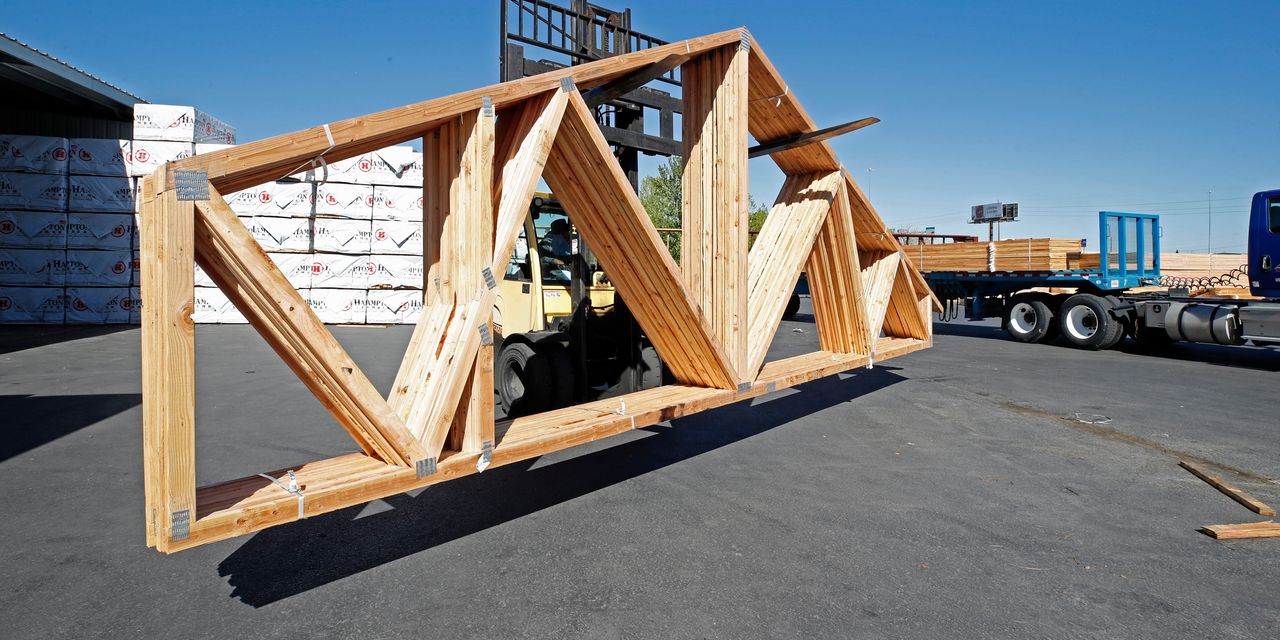Lumber prices have dropped by more than 60% so far this year, but don’t count on a recovery soon. Higher interest rates and inflation will continue to slow demand for single-family homes.
“Home builders have faced an enormous uptick in cancellations over the past several months due to the sharp rise in mortgage rates and the related softening demand for home buying,” said Alexander Snyder, portfolio manager, real estate securities, at CenterSquare Investment Management. “The trickle down of higher rates is cascading into lower demand for new houses, which leads to lower demand for lumber, which leads to lower prices for lumber.”
The most-active November futures contract for random length lumber
LBX22,
LB00,
settled at $410.80 per thousand board feet on Sept. 26. That is the lowest settlement since June 2020 and prices are down 64% year to date, according to Dow Jones Market Data. Prices have lost around 75% from the peak price during the COVID-19 pandemic of $1,670.50 on May 7, 2021.
Interest-rate hikes
The Federal Reserve last week agreed on another jumbo-sized interest-rate hike. The central bank also predicted its benchmark short-term rate would climb to as high as 4.75% in 2023 — and perhaps go even higher amid its efforts to ease inflation.
“I wish there was a painless way to do that,” Fed Chairman Jerome Powell said after the announcement of the latest rate hike on Sept. 21. “There isn’t.”
Since Powell’s comments, “markets have moved to complete capitulation mode and lumber is no exception,” said Kyle Little, chief operating officer of Sherwood Lumber.
However, lumber is likely to “overcorrect to confirm the end of the most recent cycle in the next 30 days,” he said.
Sherwood Lumber sees a “sideways to steady higher move in lumber prices, as supply continues to adjust lower to meet slower demand, along with interest rate increases dissipating and levelling out over the next three quarters,” Little said.
Housing starts
Housing demand, meanwhile, hasn’t fared well against a backdrop of rising rates.
“Lumber has witnessed complete demand destruction from a housing standpoint,” said Greg Kuta, president and CEO of lumber broker Westline Capital Strategies. It has been a “one-two gut punch” in the form of demand destruction with every kind of ratchet higher in interest rates.
When you factor in higher inflation, price appreciation over the past year, and higher interest rates, “the single family component of housing is getting annihilated,” he said.
““The single family component of housing is getting annihilated.””
There is still a housing shortage but you’re seeing a “transfer,” away from single-family homes into multifamily homes, which don’t require nearly as much “consumption of dimensional framing lumber” as single-family homes, said Kuta.
Construction on new U.S. homes, also known as housing starts, has fallen sharply in recent months, posting declines of 10.9% each, in June and July, according to data from the Commerce Department.
Housing starts in August, however, climbed by seasonally adjusted 12.2% to 1.58 million on the back of a rise in new apartment construction.
Homes are “still highly expensive for first time home buyers,” said Kuta. He roughly estimates that average mortgage payments are somewhere around $1,800 to $1,900 a month, while the cost of renting is somewhere in the range of $1,100 to $1,200.
“You’re seeing demand for housing. It’s just shifting into the multifamily component now, at the detriment of single-family [homes],” he said.
Shifts in the lumber market
Kuta also believes that demand is no longer going to be the “savior” for the lumber market. “It’s going to be supply constraints,” and the supply side of the lumber market is likely to be more “reactionary,” with producers taking production off the market when needed, he said.
Lumber is “definitely a strong precursor of what’s to come for sure,” for the economic outlook. “All commodities, including lumber, are going to continue to come under pressure,” he said.
Read: Lumber plays ‘canary in the coal mine’, cues downturn in commodities
Meanwhile, the launch last month of a new lumber futures contract has seen a slow start, “like herd of turtles,” said Kuta. The sizing of the new contract is at 27,500 board feet, a fourth the size of the legacy contracts. The last listed contract for the legacy contract is May 2023, so between now and year end, into the first quarter of next year, there is likely to be a “massive transfer” from the legacy contract to the new contract, Kuta says.
There are “bigger than better things” in store for lumber from a liquidity standpoint, he says.
Looking ahead, however, there are just “too many headwinds facing lumber,” said Kuta.
The downside for prices is probably somewhere in the $400 to $350 area, he said. The market is going to struggle to get back to $550 to $600, unless there is some sort of supply constraint event or shock to the market.
